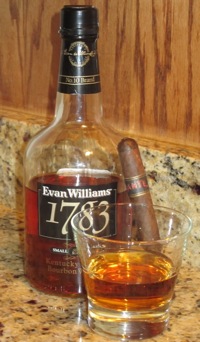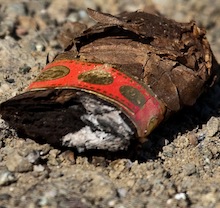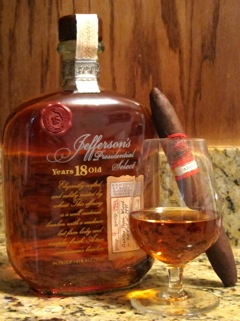Cigar Spirits: Evan Williams 1783 Small Batch Bourbon
4 Apr 2013
My last Cigar Spirits article covered one of the priciest bourbons I keep around. This time, I’m looking at one of the least expensive: Evan Williams 1783 Small Batch Bourbon.
 Just $15 will land you this bourbon from Heaven Hill Distillery which, in addition to Evan Williams and the eponymous Heaven Hill, also makes Elijah Craig, Old Fitzgerald, Larceny, and Parker’s Heritage, among others. Parker’s Heritage refers to Parker Beam (of the famous Beam bourbon family), master distiller at Heaven Hill along with his son, Craig. Since it’s founding in 1935, Heaven Hill has had a member of the Beam family as its master distiller.
Just $15 will land you this bourbon from Heaven Hill Distillery which, in addition to Evan Williams and the eponymous Heaven Hill, also makes Elijah Craig, Old Fitzgerald, Larceny, and Parker’s Heritage, among others. Parker’s Heritage refers to Parker Beam (of the famous Beam bourbon family), master distiller at Heaven Hill along with his son, Craig. Since it’s founding in 1935, Heaven Hill has had a member of the Beam family as its master distiller.
The bourbon’s namesake, Evan Williams, was a Welshman who came to Kentucky via Virginia (although technically what is now Kentucky was part of Virginia then). According to legend, he became “Kentucky’s first distiller” in 1783. He was also a politician and a businessman.
Like the flagship “Black Label” bourbon, about a decade ago the small batch Evan Williams 1783 dropped its age statement. Prior to that, it was a 10-year-old bourbon (the Black Label was a 7-year-old back then). Now we only know that its designation as a straight Kentucky bourbon without an age statement means the youngest bourbon it can contain is at least four years old, but presumably it averages a bit older than the Black Label, which also has the same restriction.
The bourbon pours a light copper color and the nose reveals honey, sawdust, and a hint of citrus. On the palate the 86-proof bourbon shows more honey along with vanilla, oak, and burnt corn. The finish is medium-length with a buttered popcorn flavor.
The result is an easy-drinking bourbon that’s enjoyable neat or with a ice cube or two, even if it isn’t as complex as many higher-priced whiskeys. Its price makes it a guilt-free ingredient in a cocktail or even a bourbon and ginger.
And obviously it goes great with a cigar. I lit up a pre-release sample of the upcoming Recluse Draconian and enjoyed the pairing. Though I actually think a more mild- or medium-bodied cigar would go even better.
Some bourbon snobs may turn their nose up at this affordable, value-packed bourbon, but don’t let that influence you. Whether you’re a seasoned bourbon drinker or a novice, this is a very respectable, enjoyable spirit that’s worth drinking with a fine cigar.
photo credit: Stogie Guys

 He notes that over the years a number of bourbons have eliminated their age statement (which designates the minimum length of time that the contained spirit aged in new charred barrels), freeing the distillers to combine any combination of straight whiskey and giving distillers increased flexibility to ramp up production more quickly without the cost of longer aging.
He notes that over the years a number of bourbons have eliminated their age statement (which designates the minimum length of time that the contained spirit aged in new charred barrels), freeing the distillers to combine any combination of straight whiskey and giving distillers increased flexibility to ramp up production more quickly without the cost of longer aging.
 The filler is Honduran and Dominican (the same as the Namakubi), while the wrapper and binder—Ecuador Habano and Honduran corojo, respectively—come from the OSOK. (Though OSOK conspicuously isn’t mentioned by name in Camacho’s press release for the cigar. I’ve heard that trademark will stay with Edgar Hoille, who now makes his cigars separate from the Camacho umbrella.)
The filler is Honduran and Dominican (the same as the Namakubi), while the wrapper and binder—Ecuador Habano and Honduran corojo, respectively—come from the OSOK. (Though OSOK conspicuously isn’t mentioned by name in Camacho’s press release for the cigar. I’ve heard that trademark will stay with Edgar Hoille, who now makes his cigars separate from the Camacho umbrella.)
 And even though they run around $100 apiece, I’d probably pick up a few more if I came across them. So while it’s an understatement to say I’m a fan of this bourbon, that’s not the whole reason why I always do a quick scan for “JPS 18” in a liquor store.
And even though they run around $100 apiece, I’d probably pick up a few more if I came across them. So while it’s an understatement to say I’m a fan of this bourbon, that’s not the whole reason why I always do a quick scan for “JPS 18” in a liquor store.
 Over the years we’ve talked quite a bit about cigars, but more recently they started talking about a project they were very excited about. I feel obliged to point out that it would be fair to say I hope they succeed. The industry, however, is full of friendly people I wish nothing but success for, and like any other new cigar this one will have to stand on its own in field already full of good smokes. I’m convinced it does.
Over the years we’ve talked quite a bit about cigars, but more recently they started talking about a project they were very excited about. I feel obliged to point out that it would be fair to say I hope they succeed. The industry, however, is full of friendly people I wish nothing but success for, and like any other new cigar this one will have to stand on its own in field already full of good smokes. I’m convinced it does.
 Patrick Ashby
Co-Founder & Editor in Chief
Patrick Ashby
Co-Founder & Editor in Chief Patrick Semmens
Co-Founder & Publisher
Patrick Semmens
Co-Founder & Publisher George Edmonson
Tampa Bureau Chief
George Edmonson
Tampa Bureau Chief